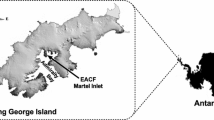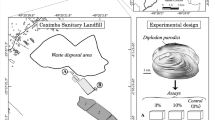Abstract
The measurement and induction of mixed function oxyigenases (MFOs) of limnetic gastropods were investigated to estimate their suitability as biomarkers. A determination of MFO activities was performed through the measurement of ethoxyresorufin-O-dealkylase (EROD), pentoxy-(PROD) and benzoxyresorufin-O-dealkylase-activity (BROD). Optimal measuring conditions of these activities were investigated in preparations of the digestive gland of 4 species of limnetic gastropods. Results indicate that MFO-activity inhibiting substances are accumulating in the microsomal pellet, the fraction commonly used for the measurement of MFO-activities. Therefore, the fraction used for induction studies was the postmitochondrial supernatant (PMS). EROD, PROD, and BROD activity ofPlanorbis planorbis andPlanorbis carinatus were measured after a treatment with Aroclor 1254 for 1–17 days. Maximal induction of EROD and PROD were 6 and 10 times the value in the control group ofP. carinatus, respectively induction inP. planorbis was lower. BROD-activity could not been measured inP. planorbis. InP. carinatus, BROD-activity increased to a maximum of 2 times after traetment with Aroclor 1254. The level of induction of EROD-activity is comparable to results described in analog studies with fish.
Similar content being viewed by others
References
Achazi, R.K.;G. Chroszcz;E. Heimig;R. Neunaber;I. Steudel (1994): A high-molecular regulator of 7-ethoxyresorufin-O-deethylase activity in fish. Comp. Biochem. Physiol. C108 (2): 243–256
Bradfort, M. (1976): A rapid and sensitive method for the quantification of microgram quantitation of protein utilising the prinziple of protein-dy-binding. Anal. Biochem.72: 248–254
Bucheli, T.D.;K. Fent (1995): Induction of cytochrome P450 as biomarker for environmental contamination in aquatic ecosystems. Crit. Rev.Environ. Science Toxicol25 (3): 201–268
Burke, M.D.;R.T. Mayer (1974): Ethoxyresorufin: direct fluorometric assay of a microsomal O-dealkylation which is preferentially inducible by 3-methylcholanthrene. Drug. Metabol. Disp.2: 583–588
Burke, M.D.;S. Thompson;C.R. Elcombe;J. Halbert;T. Haaparanta;R.T. Mayer (1985): Ehoxy-, Pentoxy and Benzyloxyphenoxazones and homologues: a series of substrates to distinguisch between different induced cytochromes P-450. Biochem. Pharmacol.34: 3337–3345
Cheach, D.M.Y.;P.F.A. Wright;D.A. Holdway;J.T. Ahokas (1995):Octopus pallidus cytochrome P-450: characterisation and induction studies with β-naphthoflavone and Aroclor 1254. Aquat. Toxicol.33: 201–214
Clark, M.A.;B.A. Bing;P.E. Gottschall;J.F. Williams (1995): Differential effect of cytokines on the phenobarbital or 3-methylcholanthrene induction of P450 mediated monooxygenase activity in cultured rat hepatocytes. Biochem. Pharmacol.49 (1): 97–104
Galli, A.;D. Del Chiero;R. Nieri;G. Bronzetti (1988): Studies on cytochrome P-450 inMytilus galloprovincialis: induction by Na-phenobarbital and ability to biotransform xenobiotics. Marine Biology100: 69–73
Goksøyr, A.;L. Förlin (1992): The cytochrome P-450 system in fish, aquatic toxicology and environmental monitoring. Aquat. Toxicol.22: 287–312
Hansen, P.D. (1993): Enzymatisches Verfahren zur Erfassung der Biotransformation (Entgiftungsaktivität) in der Fischleber — Ein Beitrag zum biologischen Effektmonitoring. in: Biochemische Methoden zur Schadstofferfassung im Wasser. Hrsg: Fachgruppe Wasserchemie, VCH Weinheim, S. 54–62
James, M.O. (1989): Cytochrome P450 monooxygenases in crustaceans. Xenobiotika19 (10): 1063–1076
Livingstone, D.R. (1985): Responses of the detoxification/ toxication enzyme systems of mollusks to organic pollutants and xenobiotics. Mar. Pollut. Bull.16: 158–164
Livingstone, D.R. (1987): Seasonal responses to diesel oil and subsequent recovery of the cytochrome P-450 monooxygenase system in the Common musselMytilus edulis L., and the Periwinkle,Littorina littorea L. Science Total Environ.65: 3–20
Livingstone, D.R.;P. Lemaire;A. Mattews;L.D. Peters;C. Porte;P.J. Fitzpatrick;L. Förlin;C. Nasci;V. Fossato;N. Wootton;P. Goldfarb (1995): Assessment of the impact of organic pollutants on Goby (Zosterisessor ophiocephalus) and Mussel (Mytilus galloprovincialis) from the Venice Lagoon, Italy: Biochemical studies. Marine Environ. Res.39: 233–240
Melancon, M.J.;J.J. Leach (1983): Dose-effect relationship for inductoin of hepatic monooxygenase activty in Rainbow Trout and Carb by Aroclor 1254. Aquat. Toxicol.4: 51–61
Michel, X.R.;P. Suteau;L.W. Robertson;J.-F. Narbonne (1993): Effects of benzo(a)pyrene, 3,3′,4,4′-tetrachlorobiphenyl and 2,2′,4,4′,5,5′-hexachlorobiphenyl on the xenobiotic-metabolizing enzymes in the musselMytilus galloprovincialis. Aquatic Toxicol.27: 335–334
Miranda, C.L.;M.C Henderson;J.-L. Wang;H.S. Nakaue;D.R. Buhler (1992): Comparative effects of the polychlorinated biphenyl mixture, Aroclor 1242, on porphyrin and xenobiotic metabolism in kidney of Japanese quail and rat. Comp. Biochem. Physiol. C103: 149–152
Robertson, L.W.;E.M. Silberhorn;H.P. Glauert;M. Schwarz;A. Buchman (1991): Do structure-reactivity relationships for the acute toxicity of PCB’s and PBB’s also apply for induction of hepato-cellular carcinoma? Environ. Toxicol. Chem.10: 715–726
Romeo, M.;A. Mathieu;M. Gnassia-Barelli;A. Romana;M. Lafaurie (1994): Heavy metal content and biotransformation enzymes in two fish species from the NW Mediterranean. Marine Ecology Progress Series107 (1–2): 15–22
Sleiderink, H.M.;J.M. Everaarts;A. Goksøyr;J.P. Boon (1994): Hepatic cytochrome P4501A induction in Dab (Limanda limanda) after oral dosing with the polychlorinated biphenyl mixture Clophen A40. Environ. Toxicol. Chem.14: 679–687
Stegeman J.J.;P.J. Kloepper-Sams (1987): Cytochrome P-450 isozymes and monooxygenase activity in aquatic animals. Environ. Health Perspect.17: 87–95
Stegeman, J.J.;J.J. Lech (1991): Cytochrome P-450 monooxygenase system in aquatic species: carcinogen metabolism and biomarker for carcinogen and pollutant exposure. Environ. Health Pers.90: 101–109
Van den Heuvel, M.R.;K.R. Muntkittrick;J.J. Stegeman;D.G. Dixon (1995): Second-round interlaboratory comparison of hepatic microsomal ethoxyresorufin-O-deethylase actvity in white sucker (Catostomus commersoni) exposed to bleachedkraft pulp mill effluent. Environ. Toxicol. Chem.14: 1513–1520
Yawetz, A.;R. Manelis;L. Fishelson (1992): The effects of Aroclor 1254 and petrochemical pollutants on cytochrome P450 from digestive gland microsomes of four mediterranean mollusks. Comp. Biochem. Physiol. C103: 607–614
Author information
Authors and Affiliations
Rights and permissions
About this article
Cite this article
Meimberg, H., Schrenk, C., Steinberg, C. et al. The suitability of gastropods as biomarkers. Environ. Sci. & Pollut. Res. 4, 183–188 (1997). https://doi.org/10.1007/BF02986340
Received:
Accepted:
Issue Date:
DOI: https://doi.org/10.1007/BF02986340




